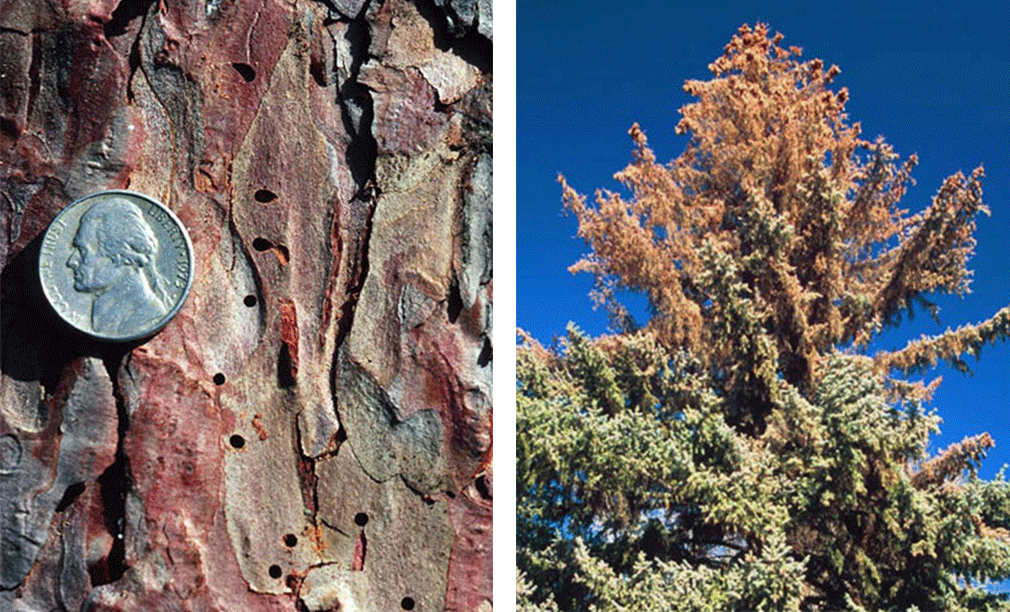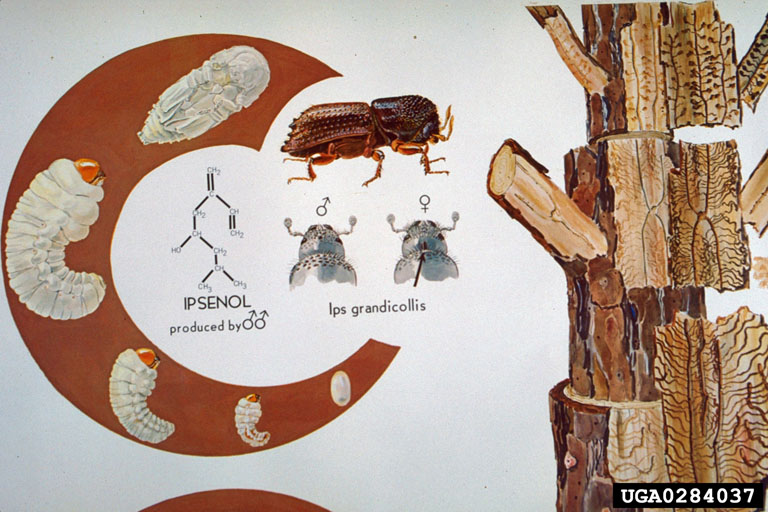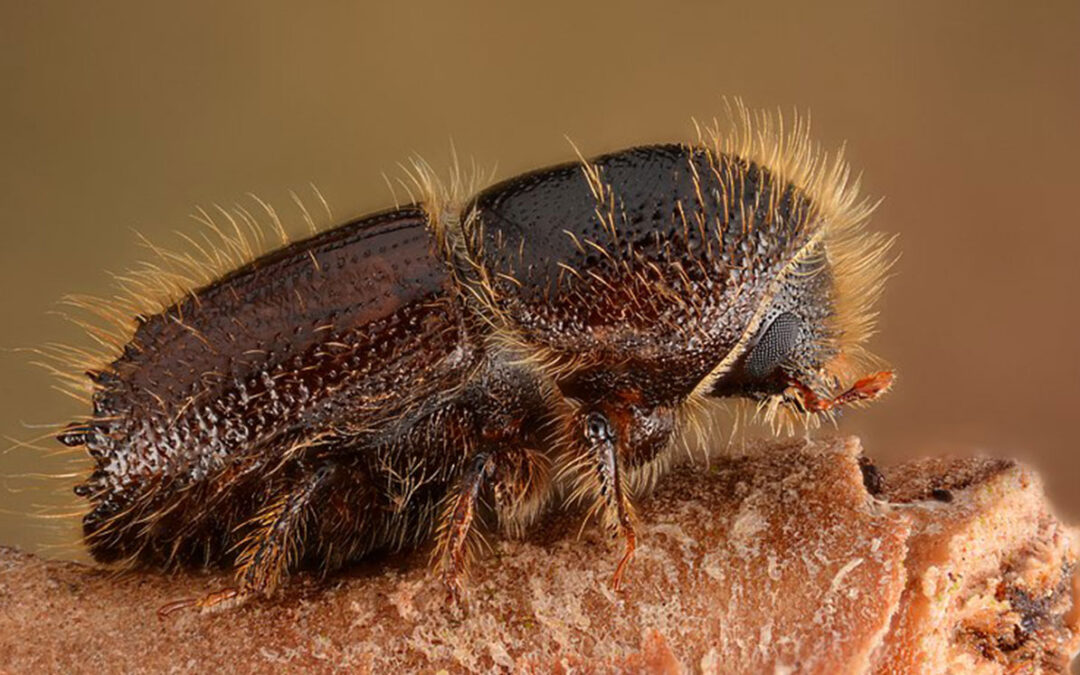Time to Protect Spruce, Ponderosa, and Austrian Pine Trees
Ips Beetles are native to Colorado and are now on the move in Denver. Their larvae damage spruce and pine trees, so the best time to treat is when the adult males become active in April and May each year. They typically bore into weakened trees to form mating galleries. However, Ips will attack healthy trees in large outbreaks. Homeowners should look for signs of beetle activity, such as pitch tubes and sawdust-like frass collecting at the base of trunks. Ross Tree Arborists can save some trees if insect damage is found early; however, established Ips infestations are not treatable.
Prevention is the best tact against these engraver beetles. Homeowners can help their conifers resist these pests by regularly watering and fertilizing their trees yearly. We recommend treating high-value trees twice yearly, mainly if the neighborhood has infected spruce and pine trees. Treatments should be applied when overwintering adults get active in the spring and when their larvae pupate and emerge as adults. It is not unusual for these insects to have several generations each season. Ill product application timing wastes money, so hiring a professional treatment company like Ross Tree for Ips prevention and control is best.
Ips Beetles are small bark insects that are 1/8 to 3/8 inches long. There are eleven species native to Colorado. Ips Beetles usually limit their attacks to wounded or stressed trees. However, when large infestations occur, they will attack healthy trees. Their larvae develop under the bark and produce girdling tunnels that can cause dieback. The Ips piliferous and Ips hunters attack Spruces. Four species attack Ponderosa and Austrian Pines. Their appearances are so similar that it takes an Entomologist to tell them apart.
Ips Beetle Tree Injury

These beetles hear tree vascular systems shutting down and smell trees in distress. When a host is found, the males borrow into the tree and excavate nuptial chambers. Then, they release aggregation pheromones which encourage mass attack behavior. The males push out yellowish- or reddish-brown boring dust that accumulates in bark crevices or around the base of trunks. When the larval tunnel, they extend the damage to a tree’s vascular system causing needle discoloration and fading. When the larvae pupate and become adults, they create small round exit holes in the bark of infested trees to move to another part of the same tree or neighboring conifers. In time, consecutive generations “fill” the tree and ultimately kill the host. The presence of woodpeckers is a sign of Ips infestations. The birds sometimes remove tree bark, searching for beetles to eat.

Life History
Adults overwinter under the bark or in yard litter. When spring arrives, they start looking for weakened trees. The males bore into the tree engraving “nuptial chambers” and attract females by producing pheromones. After mating, the females engrave egg galleries off the nuptial chambers that take “Y” or “H” shaped patterns. The females push all the boring dust out before laying eggs along the gallery. The tunneling takes off as the eggs hatch producing young white, legless larvae that carve out lateral galleries in the sapwood. In Colorado, two to four generations of these beetles usually develop yearly.
Ips Beetle Management
Ips Beetles attack stressed trees, so the best approach is to grow healthy trees. Since we live in an arid climate, city Spruces or Pines benefit from deep root watering and feeding. Healthy trees use pitch and other defense mechanisms to push beetles out of the tree. Insecticides work when adults land on trees to start the mating cycle or when they emerge. However, no chemical treatment exists for trees or wood already infested by Ips Beetles. What makes treatment problematic is that Ips Beetles can have numerous overlapping mating cycles. Control products need to be applied before adult beetle infestation. In Colorado, adults enter trees during warm days as early as late-February on through November. Because of this extended activity, Ross Tree recommends two treatments in the early spring and summer to protect trees during infestations. In 2022, most Spruces and Pine growing in Denver yards and parks are threatened by Ips. Tall, mature Spruce or Pine yard trees are worth saving. A good rule of thumb when deciding whether to treat or not is to survey the neighborhood for infested beetle-killed trees within sight of the trees in question. If the insects are active, then all high-value trees need immediate treatment. Recently planted Spruce, Ponderosa, and Austrian trees warrant protection, too.
What Causes Ips Beetle Treatment Failure?
Treatment application timing is key to saving trees from Ips, so it is best to hire a professional tree service licensed by the State of Colorado for control product applications. If a treated tree later dies of beetle attack, it is usually for one of the following reasons:
- No Ips Adults on Tree
Spraying the tree after the beetles bored into the tree.
- Wrong Control Product Concentration
The spray did not have the right product concentration to be effective.
- Incorrect Spray Application
When spraying, the control product application missed parts of the bark surface.
- Bad Timing
The timing was off, so the control product wore off and was no longer effective.
Tree Removal
Large trees are succumbing to Ips across the city. Ross Tree is known for its ability to handle large jobs or tree removals that require street closings. We have the equipment to remove the largest conifers that have died from this insect infestation.
Most homeowners turn to professional tree service companies to treat their conifers for Ips Beetle because of the insects’ breeding cycle complexity. Ross Tree has three Quality Supervisors licensed by the State of Colorado to apply control products. We also have three certified arborists on staff. Homeowners who did not water their Spruces, Ponderosa, and Austrian Pines this winter and spring trees should call 303-871-9121 or fill out a service request form. We will do our best to save high-value yard trees.

